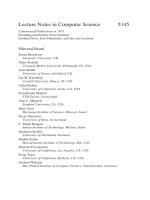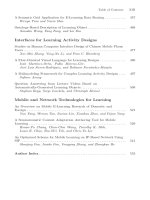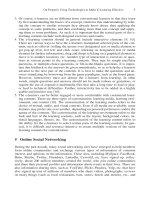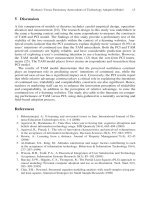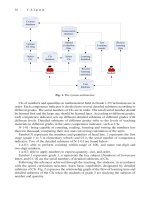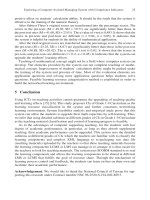Lecture Notes in Computer Science- P12 pps
Bạn đang xem bản rút gọn của tài liệu. Xem và tải ngay bản đầy đủ của tài liệu tại đây (208.05 KB, 5 trang )
Recommendation in Education Portal by Relation Based Importance Ranking 45
3. Iteratively calculate the importance rank vector.
Let
S
be the current stage, which is number
n
itera-
tion, result of importance score. Then
S’ = (A’)
T
S
,
S’
is the importance rank result in
n+1
iteration.
Calculate the variance of all the entities’ impor-
tance rank in
S’
and
S
by
∑
−
′
=
i
ii
ssv )( .
4. if (
ε
<v or n==m) goto 4; else repeat 3.
5. Output the importance rank of every entity in the
education portal.
Recommend the top n resources. Although in our approach, the importance of every
entity can be achieved, we only recommend the top n resources to web page visitors.
However, if we want to recommend other typed entities like users, it’s also straight
forward to do that kind of recommendation.
4 Experiments
In this section, we give experimental result in a real world data set. The real world
data set is made up of academic papers published by three departments of Tsinghua
University: Department of Computer Science, Department of Electronic Engineering
and Department of Automation. The network can be constructed by the following
elements:
1. Resource: paper is the resource in this experiment;
2. User: paper author is the user in this experiment;
3. Tag: keyword of the paper is the tag in this experiment;
4. Department: there are three departments in this experiment;
5. Category: research fields in these three departments are categories in this ex-
periment;
6. User-resource relation: author of a paper will have this relation between
him/her and the paper;
7. User-tag relation: author of a paper will have relations between him/her and
the paper’s tags;
8. Tag-resource relation: tags of a paper will have relations between them and
the paper;
9. Resource-category relation: the papers belong to one research field will have
relations between them and the category represents the research field;
10. Category-department relation: the research fields belong to one department
will have relations between them and the department;
11. Department-user relation: the department will have the relation to users if the
users are belonged to this department.
By this method, we extract 300 papers in these three departments. The papers are
from the IEEE Explorer [7] web site. We get the network with the following numbers
of nodes and relations:
46 X. Wang, F. Yuan, and L. Qi
Table 1. The number of entities and relations
Resource 300
User 82
Tag 412
Department 3
Entity
Category 18
User-resource 950
User-tag 1330
Tag-resource 542
Resource-category 300
Category-department 18
Relation
Department-user 82
The tags are prepared by extracting the keywords from the papers in the following
two approaches: the first one is to extract the words in the “keyword” section in the
paper. If the paper doesn't contain the “keyword” section, the tags are extracted by
getting the first three frequent words in the papers’ abstract. The tags are extracted
mainly in a manual way.
The categories are prepared by using the papers’ conferences and journals in which
the paper is published. The conferences and journals have been classified to different
categories, for example, database, communications, machine learning.
To evaluate the performance of our importance rank calculated by our approach,
we use people to annotate the results output by our approach. The algorithm outputs
500 pairs which contain two resources, the first resource’s importance score is larger
than the second one. If a tester agrees with this result, he/she will approve this result.
Otherwise, he/she will decline this result. Because different testers may have different
opinions about the results, the final result is achieved by a voting method. We use five
undergraduate and graduate students as the tester and randomly generate 500 pairs of
the results for them to annotate. The evaluation factor is the error rate of the evalua-
tion result.
)(
)(
resultnumber
resultdeclinednumber
err
rate
=
(11)
And we have repeated generation 500 pairs for five times, for each time, the error
rate is as follows:
Table 2. The error rate in five randomly generated test sets
Test set 1 Test set 2 Test set 3 Test set 4 Test set 5
0.20 0.18 0.21 0.23 0.20
Recommendation in Education Portal by Relation Based Importance Ranking 47
The average error rate is 0.20, which is acceptable for users to find information
which may interest him/her.
We also try to use different λ
ut
and λ
ur
values to inspect how the values affect the
results. We calculate the average error rate using the same method in above. We re-
peated generation 500 pairs for five times and calculate the average error rate. The
experimental results are as follows:
Table 3. The result comparison in different values of λ
ut
and λ
ur
λ
ut
λ
ur
Average error rate
0.9 0.1 0.28
0.8 0.2 0.26
0.7 0.3 0.24
0.6 0.4 0.20
0.4 0.6 0.18
0.3 0.7 0.21
0.2 0.8 0.25
0.1 0.9 0.27
We can find that in this scenario, the results are better when λ
ut
is relatively a little
smaller than λ
ur
. However, we can get the best result when λ
ut
= 0.4 and λ
ur
=0.6,
which is 0.18. And it’s not much different from 0.20, which is obtained when we set
λ
ut
=λ
ur
=0.5.
5 Related Works
Recommendation has been a popular research topic in both industry and academic.
However, there are still few researches about recommendation in education portal.
Thus, we will review the current methods in other kinds of applications.
Online sellers usually use recommendation to encourage customers to buy more
items. For example. www.amazon.com, www.joyo.com and www.taobao.com all
have their own methods on recommendations. Usually, such recommendation ap-
proaches consider different aspects like discovering the associations of different items
and users [8], mining the users’ profile and behavior logs [8], and the matching of
item profiles [9].
Except online sellers, many web based applications use recommendation to push
the potential interesting items to users when users are searching for something or
viewing something. For example, www.youtube.com recommends related videos to
users when they are viewing a video. recommends related
news when user is viewing a piece of news. Related item recommendation is usually
implemented using the similarity calculation based on contents and metadata of the
items [10].
48 X. Wang, F. Yuan, and L. Qi
6 Conclusions
In this paper, we have investigated the problem of recommendation in education
portal. We have noticed the semantically explicit relations between entities in the
education portal and used them to get better results of recommendation. We have
formalized the recommendation as an importance ranking problem. By using the
approach based on random walk, we have calculated the importance rank of each
entity in the education portal. Finally, we have evaluated the results of our approach
in real world data set.
Future works can be summarized as follows:
1. We will apply this approach into the real education portal inside Tsinghua
University, which is , this web site is managed by
our department and we are now working on adding this recommendation to it.
The scenario could be as follows: When a student logins into Tsinghua’s edu-
cation portal, the most important and useful courseware for the student will
be recommended and displayed explicitly.
2. We will use this approach in more complex recommendation scenario. For
example, to combine this approach in recommendation of entity query. In en-
tity query, the importance rank will be combined with the content relevance
to do recommendation.
References
1. Michael, P., Daniel, B.: Content-Based recommendation systems. The Adaptive Web,
325–341 (2007)
2. Kyoung-jae, K., Hyunchul, A.: A recommendation system using GA K-means clustering
in an online shopping market. Expert Systems with Applications 34(2), 1200–1209
3. Lin, W., Alvarez, S.A., Rujz, C.: Collaborative recommendation via adaptive association
rule mining. In: WebKDD workshop (2000)
4. Zan, H., Wingyan, C., Hsinchun, C.: A graph model for e-commerce recommender sys-
tems. Journal of the American Society for Information Science and Technology 55(3),
259–274
5. Sergey, B., Lawrence, P.: The anatomy of a large-scale hypertextual web search engine.
Computer Networks and ISDN Systems 30(7), 107–117
6. Barber, M.N., Ninham, B.W.: Random and restricted walks. Gordon and Breach, New
York (1970)
7. IEEE explorer,
8. Linden, G., Smith, B., York, J.: Amazon.com recommendations: item-to-item collabora-
tive filtering. Internet Computing 7(1), 76–80
9. Markus, Z., Markus, J., Dietmar, J., Sergiu, G.: Comparing recommendation strategies in a
commercial context. IEEE Intelligent Systems 22(3), 69–73
10. Resnick, P., Iacovou, N., Sushak, M., Bergstrom, P., Riedl, J.: GroupLens: An open archi-
tecture for collaborative filtering of netnews. In: Proceedings of the 1994 Computer Sup-
ported Collaborative Work Conference (1994)
F. Li et al. (Eds.): ICWL 2008, LNCS 5145, pp. 49–58, 2008.
© Springer-Verlag Berlin Heidelberg 2008
Research on Learning Resources Organization Model
Qingtang Liu
1
and Zhimei Sun
2,
*
1
Huangzhong Normal University,
Wuhan, China, 430079
2
Law and Business College of Hubei University of Economics,
Wuhan, China, 430079
Abstract. The paper studies the adaptive learning content organization model
and algorithm, which takes knowledge point as a unit. At first, it defines granu-
larity of learning object, designs learning content level framework, which takes
knowledge point as the meaning unit, builds up the reusable and sharable foun-
dation of learning resources. The second is to provide the basic scheduling
model for learning content organization. The model involves in pre-test, survey,
knowledge point scheduling modules, summary, and post-test. Learning content
scheduling algorithm is designed to choose learning content according to the
learning content sequence, learner’s styles, learning evaluating outcomes and
application context. Lastly, the scheduling algorithm is proved effectiveness
and stable in E-learning Service Platform.
Keywords: learning objects, Organization model, scheduling algorithm.
1 Introduction
As an opening learning form, e-learning has broken the time and space limit in tradi-
tional education, enables the learner to carry on the effective active learning. Research
on control, management and evaluation of learning process, learning and teaching
model, adaptive learning system etc. have become the hotspot in e-learning. The
adaptive schedule of learning content has become the key of active, personalized,
effective learning. Now, the learning content scheduling algorithm mainly focuses on
subjective characteristic, learning content characteristic, learning strategy and intelli-
gent decision-making. Along with the development of information technology, some
problems come out as follows.
The first problem is granularity of learning object [1]. In order to reuse and share
learning resources, many e-learning technology standards organizations, such as
IEEE, IMS[2], have formulated the correlative standards in abundance, in which they
show the freedom definition for the granularity of learning object as a knowledge
point, or a unit, or a curriculum. However, the effective scheduling and combination
*
Corresponding author.
